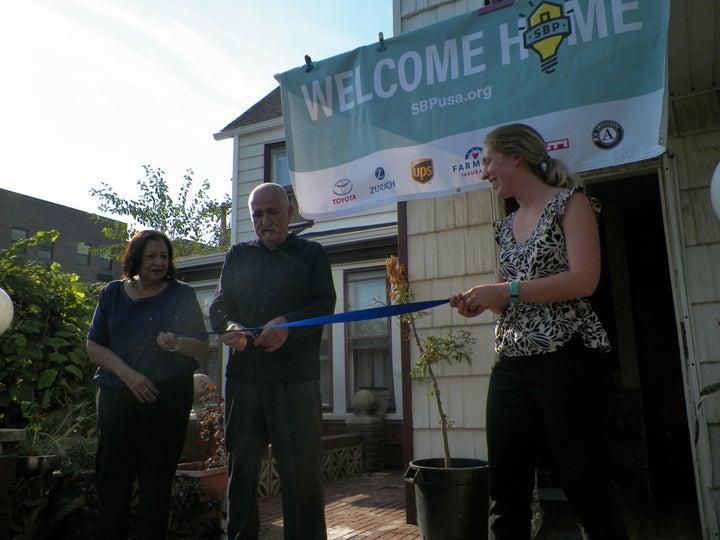
Welcoming a Rockaway family home.
Making Disaster Recovery Work
Last week, Mayor DeBlasio made two significant announcements. First that NYC’s historically troubled Superstorm Sandy home repair and replacement program, Build it Back, which has served less than 50% of the nearly 20,000 original applicants, will not meet his previously stated goal of completion of construction on all projects by the end of 2016. To address this unmet need, DeBlasio then announced he will be re-allocating $500MM from the city’s budget to complete home repairs and replacement. These announcements were accompanied by a 27-page report that raised more questions than it answered.
While the report clearly organizes and lists the challenges the program has encountered, it offers very little substance on how these issues will be resolved or how future overages will be avoided. Each challenge listed throughout the in the Mayor’s overview is likely worthy of it’s own 27-page report. More importantly – the report offers no new goal or timeline for the completion of construction on the ~8,500 applicants who remain to be served by the program.
While the Mayor’s report promises in-depth treatment of the most difficult challenges in the future, we have serious reasons to doubt this. He explains the high dropout rate among initial applicants as “losing the first year of recovery to inertia” but what does that mean? It means applicants walked away because they had no resources, no communication, no plan and no hope. If a $500MM budget deficit doesn’t prompt a deeper explanation of the programmatic problems and proposed solutions, then I am not sure what will.
Disaster Recovery is often mistaken as an activity, or a period in time. This is not correct. Disaster Recovery is an industry with money and markets and contracts like any other. What it lacks in common with most industries is a natural process for filtering leaders and experts. Time and again newly elected/appointed officials are thrust in to the billet of 'industry leader' and challenged to oversee the months and years of long-term recovery that follow. The learning curve is steep and few survive (look at BiB’s early history). Still fewer can turn a recovery in to something to highlight (it is a disaster after all). This series of events plays out repeatedly in affected states, counties, and municipalities all across the country each and every year.
New York is unique, but it’s no exception.
Despite the program’s many failures and significant cost overruns - Build it Back still has an opportunity to improve in the home stretch and to better serve those applicants who are still waiting. Here are a few suggestions:
- Define success for all involved. While the 2016 goal wasn’t met, it was a clearly stated goal and this is important. Set a new goal as soon as possible so that we can all commit and rally around it. Make customer service and employee culture a part of it - taxpayer dollars and four years of waiting are worthy of this effort.
- Have others take a look. An external operations audit will help gather more useful data about what went wrong. External evaluation and analysis is a necessary condition for objectivity, and objective data drives better strategy and tactics.
- Create a strategic/tactical review task force – a sort of “special operations” team comprised of senior officials in relevant departments meant to streamline processes, and guide difficult cases to conclusion.
- Use every tool in the kit. Qualified non-profit organizations have been massively underutilized. SBP can take on an additional 30-40 projects tomorrow – we’ve offered this multiple times. The offer stands.
- The picture is even bigger. This is an opportunity for NYC to bring improvements to the industry as a whole, but only if we seize it.
Whatever the final outcome - Build it Back’s failures can function as an informative filter for recovery tactics and strategies in future disasters. But this can only happen if we take the time to evaluate performance, collect information, and use it to design more coherent strategy and more effective tactics. Mayor DeBlasio must remember that NYC is a leader – whether our compass works or not.
# # #
Reese May is the National Director of Recovery for SBP, a national long-term disaster resilience and recovery nonprofit organization which was founded in 2006 and has operated in seven states. May served two tours with the Marine Corps in Iraq and has since lead SBP’s recovery efforts across Louisiana, Missouri, New York, New Jersey, South Carolina and West Virginia. In his role, May works closely with municipal and state level officials to share lessons learned and best practices developed through SBP’s innovative model over the past decade.
About SBP
SBP's mission is to shrink time between disaster and recovery. Since its founding in 2006 in St. Bernard Parish, Louisiana following the devastation wrought by Hurricane Katrina, SBP has rebuilt homes for more than 1,170 families with the help of 150,000 volunteers in New Orleans; Joplin, MO; Staten Island, NY; Rockaway, NY; Monmouth and Ocean Counties, NJ; San Marcos, TX; Columbia, SC; White Sulphur Springs, WV and Baton Rouge, LA.
SBP’s model is enhanced by AmeriCorps, which provides 180 members annually to manage worksites and clients, and train the organization’s volunteers nationally.
Through its Disaster Resilience and Recovery Lab (DRRL), SBP works to share lessons learned, prevent common barriers to recovery and help communities utilize SBP’s standardized, repeatable and proven-effective model.
SBP shrinks time between disaster and recovery via five interventions:
- Build innovatively, driving efficiency
- Share SBP’s proven effective model with other organizations to increase efficacy across the disaster rebuilding sector
- Train home and business owners in resilience and risk mitigation prior to disaster
- Advise local and state government officials so they can deploy federal dollars sooner, and in a way that empowers an efficient recovery
- Advocate so that what is measured is what matters – a complete recovery
To learn more, visit www.SBPUSA.org and like/follow on Facebook & Twitter @SBPUSA
